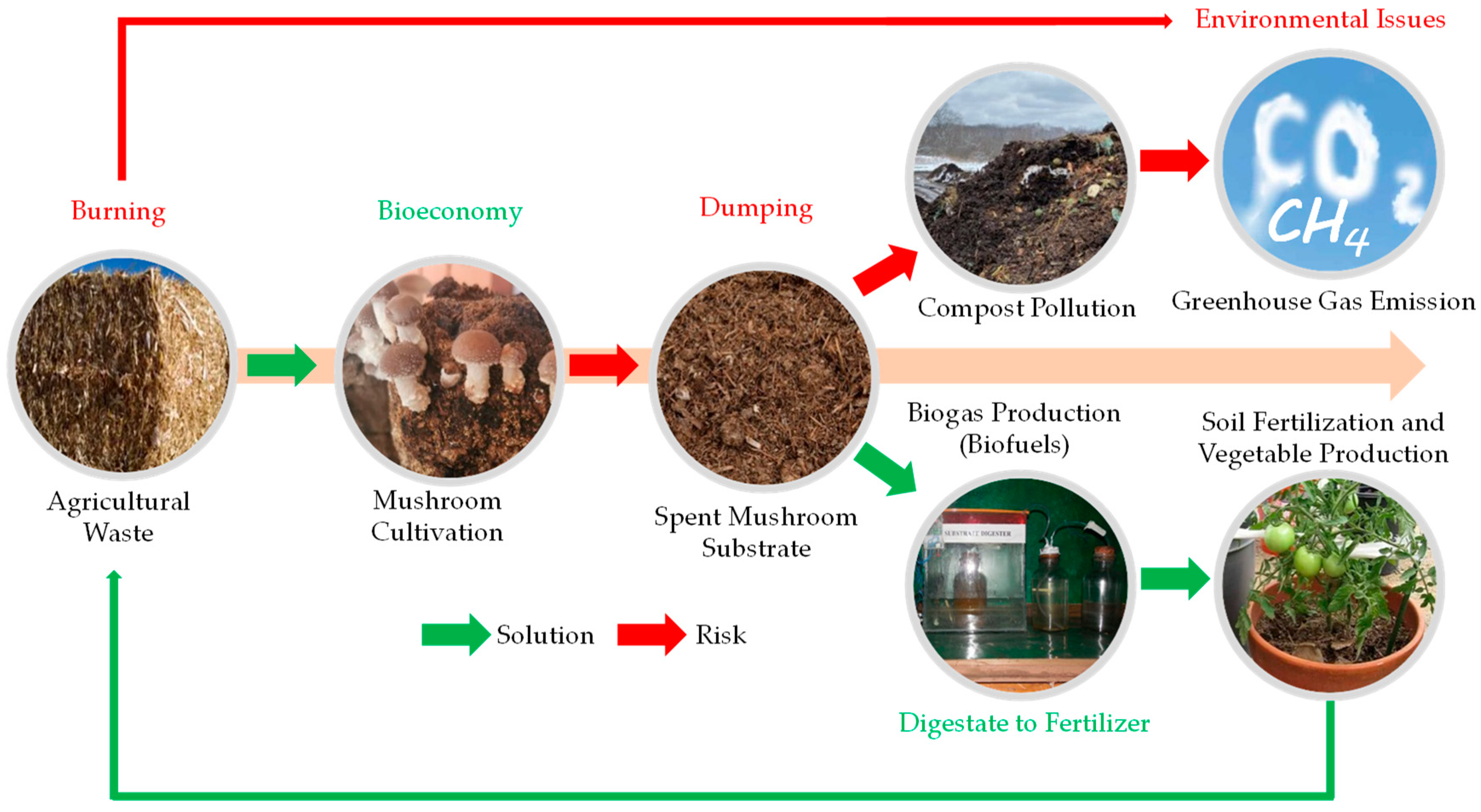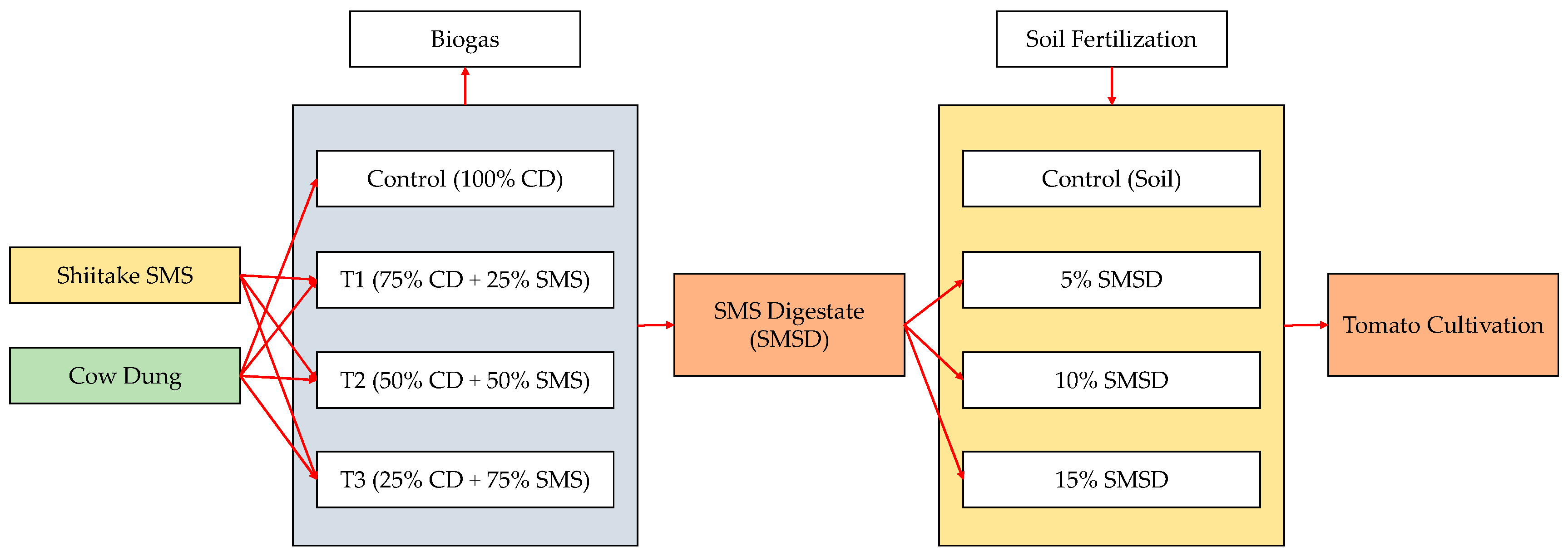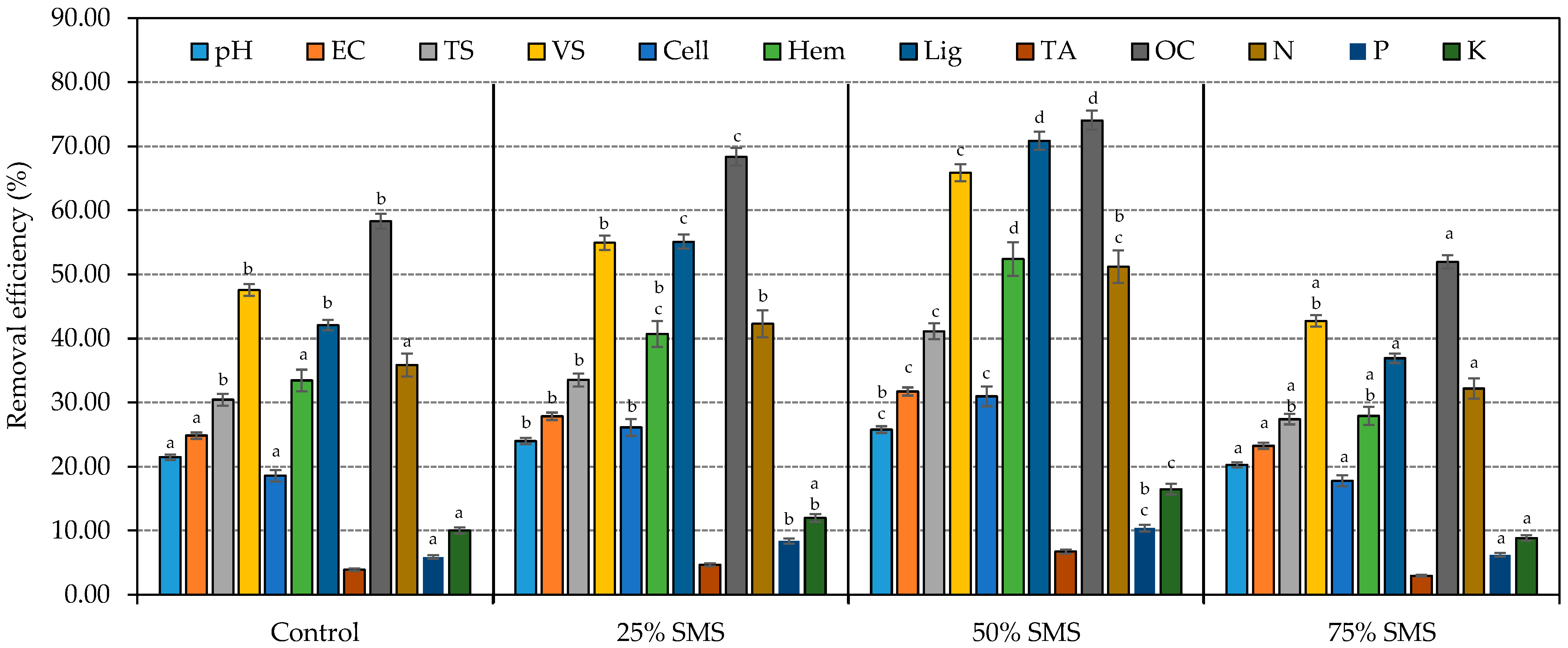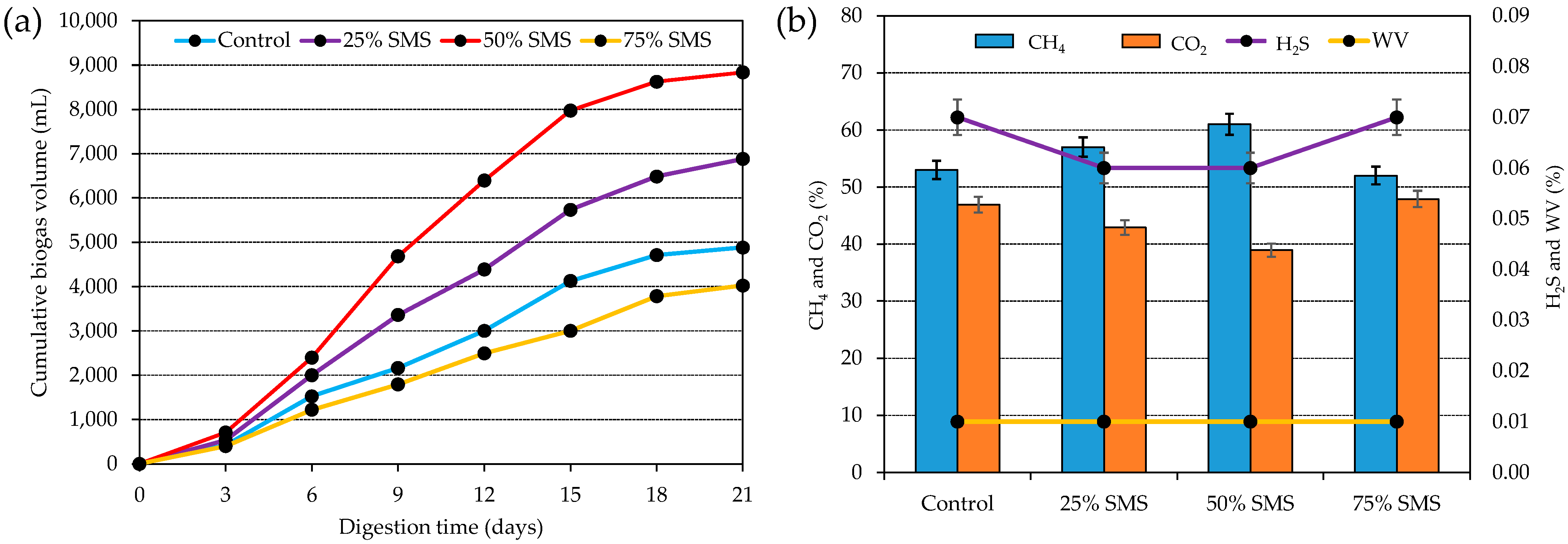Biotransforming the Spent Substrate of Shiitake Mushroom (Lentinula edodes Berk.): A Synergistic Approach to Biogas Production and Tomato (Solanum lycopersicum L.) Fertilization
Abstract
:1. Introduction
2. Materials and Methods
2.1. Experimental Materials
2.2. Experimental Design for Biogas Production Using SMS
2.3. Experimental Design for Crop Cultivation Using SMS Digestate
2.4. Chemical, Analytical, and Instrumental Methods
2.5. Data Analysis and Software
3. Results and Discussion
3.1. Physicochemical and Proximate Composition of CD and SMS
3.2. Changes in Biogas Slurry before and after AD
3.3. Biogas Production Potential of Shiitake SMS
3.4. Effect of SMSD on Soil Properties
3.5. Effect of SMSD on Seedling, Growth, and Yield of Tomato
4. Conclusions
Author Contributions
Funding
Institutional Review Board Statement
Informed Consent Statement
Data Availability Statement
Acknowledgments
Conflicts of Interest
References
- Royse, D.J.; Baars, J.; Tan, Q. Current Overview of Mushroom Production in the World. In Edible and Medicinal Mushrooms; John Wiley & Sons, Ltd.: Chichester, UK, 2017; pp. 5–13. [Google Scholar]
- Gonani, Z.; Riahi, H.; Sharifi, K. Impact Of Using Leached Spent Mushroom Compost As A Partial Growing Media For Horticultural Plants. J. Plant Nutr. 2011, 34, 337–344. [Google Scholar] [CrossRef]
- Carrasco, J.; Zied, D.C.; Pardo, J.E.; Preston, G.M.; Pardo-Giménez, A. Supplementation in Mushroom Crops and Its Impact on Yield and Quality. AMB Express 2018, 8, 146. [Google Scholar] [CrossRef] [PubMed] [Green Version]
- EEA European Environment Agency. Nitrate Directive. 2022. Available online: https://www.eea.europa.eu/archived/archived-content-water-topic/water-pollution/prevention-strategies/nitrate-directive (accessed on 3 May 2022).
- Stewart, D.P.C.; Cameron, K.C.; Cornforth, I.S. Inorganic-N Release from Spent Mushroom Compost under Laboratory and Field Conditions. Soil Biol. Biochem. 1998, 30, 1689–1699. [Google Scholar] [CrossRef]
- Gerrits, J.P.G. Samenstelling van Afgewerkte Champignonmest. Champignoncultuur 1992, 36, 91–93. [Google Scholar]
- Ahlawat, O.P.; Gupta, P.; Kumar, S.; Sharma, D.K.; Ahlawat, K. Bioremediation of Fungicides by Spent Mushroom Substrate and Its Associated Microflora. Indian J. Microbiol. 2010, 50, 390–395. [Google Scholar] [CrossRef] [PubMed] [Green Version]
- Kwack, Y.; Song, J.H.; Shinohara, Y.; Maruo, T.; Chun, C. Comparison of Six Spent Mushroom Composts As Growing Media for Transplant Production of Lettuce. Compos. Sci. Util. 2012, 20, 92–96. [Google Scholar] [CrossRef]
- Van Tam, N.; Wang, C.-H. Use of Spent Mushroom Substrate and Manure Compost for Honeydew Melon Seedlings. J. Plant Growth Regul. 2015, 34, 417–424. [Google Scholar] [CrossRef]
- Lou, Z.; Sun, Y.; Zhou, X.; Baig, S.A.; Hu, B.; Xu, X. Composition Variability of Spent Mushroom Substrates during Continuous Cultivation, Composting Process and Their Effects on Mineral Nitrogen Transformation in Soil. Geoderma 2017, 307, 30–37. [Google Scholar] [CrossRef]
- Zhu, H.-J.; Sun, L.-F.; Zhang, Y.-F.; Zhang, X.-L.; Qiao, J.-J. Conversion of Spent Mushroom Substrate to Biofertilizer Using a Stress-Tolerant Phosphate-Solubilizing Pichia Farinose FL7. Bioresour. Technol. 2012, 111, 410–416. [Google Scholar] [CrossRef]
- Abou Fayssal, S.; el Sebaaly, Z.; Alsanad, M.A.; Najjar, R.; Böhme, M.; Yordanova, M.H.; Sassine, Y.N. Combined Effect of Olive Pruning Residues and Spent Coffee Grounds on Pleurotus ostreatus Production, Composition, and Nutritional Value. PLoS ONE 2021, 16, e0255794. [Google Scholar] [CrossRef]
- Kumar, P.; Eid, E.M.; Al-Huqail, A.A.; Širić, I.; Adelodun, B.; Abou Fayssal, S.; Valadez-Blanco, R.; Goala, M.; Ajibade, F.O.; Choi, K.S.; et al. Kinetic Studies on Delignification and Heavy Metals Uptake by Shiitake (Lentinula edodes) Mushroom Cultivated on Agro-Industrial Wastes. Horticulturae 2022, 8, 316. [Google Scholar] [CrossRef]
- Kumar, P.; Kumar, V.; Adelodun, B.; Bedeković, D.; Kos, I.; Širić, I.; Alamri, S.A.M.; Alrumman, S.A.; Eid, E.M.; Abou Fayssal, S.; et al. Sustainable Use of Sewage Sludge as a Casing Material for Button Mushroom (Agaricus bisporus) Cultivation: Experimental and Prediction Modeling Studies for Uptake of Metal Elements. J. Fungi 2022, 8, 112. [Google Scholar] [CrossRef] [PubMed]
- Adelodun, B.; Kareem, K.Y.; Kumar, P.; Kumar, V.; Choi, K.S.; Yadav, K.K.; Yadav, A.; El-Denglawey, A.; Cabral-Pinto, M.; Son, C.T.; et al. Understanding the Impacts of the COVID-19 Pandemic on Sustainable Agri-Food System and Agroecosystem Decarbonization Nexus: A Review. J. Clean. Prod. 2021, 318, 128451. [Google Scholar] [CrossRef]
- Royse, D.J. Recycling of Spent Shiitake Substrate for Production of the Oyster Mushroom, Pleurotus sajorcaju. Appl. Microbiol. Biotechnol. 1992, 38, 179–182. [Google Scholar] [CrossRef]
- Fang, W.; Ye, J.; Zhang, P.; Zhu, X.; Zhou, S. Solid-State Anaerobic Fermentation of Spent Mushroom Compost for Volatile Fatty Acids Production by PH Regulation. Int. J. Hydrogen Energy 2017, 42, 18295–18300. [Google Scholar] [CrossRef]
- Mohd Hanafi, F.H.; Rezania, S.; Mat Taib, S.; Md Din, M.F.; Yamauchi, M.; Sakamoto, M.; Hara, H.; Park, J.; Ebrahimi, S.S. Environmentally Sustainable Applications of Agro-Based Spent Mushroom Substrate (SMS): An Overview. J. Mater. Cycles Waste Manag. 2018, 20, 1383–1396. [Google Scholar] [CrossRef]
- Lin, Y.; Ge, X.; Liu, Z.; Li, Y. Integration of Shiitake Cultivation and Solid-State Anaerobic Digestion for Utilization of Woody Biomass. Bioresour. Technol. 2015, 182, 128–135. [Google Scholar] [CrossRef]
- Gao, X.; Tang, X.; Zhao, K.; Balan, V.; Zhu, Q. Biogas Production from Anaerobic Co-Digestion of Spent Mushroom Substrate with Different Livestock Manure. Energies 2021, 14, 570. [Google Scholar] [CrossRef]
- Kumar, P.; Kumar, V.; Singh, J.; Kumar, P. Electrokinetic Assisted Anaerobic Digestion of Spent Mushroom Substrate Supplemented with Sugar Mill Wastewater for Enhanced Biogas Production. Renew. Energy 2021, 179, 418–426. [Google Scholar] [CrossRef]
- Kumar, V.; Kumari, S.; Kumar, P. Management and Sustainable Energy Production Using Flower Waste Generated from Temples. In Environmental Degradation: Causes and Remediation Strategies; Agro Environ Media—Agriculture and Ennvironmental Science Academy: Haridwar, India, 2020; pp. 154–165. [Google Scholar]
- Kumar, V.; Kumar, P.; Kumar, P.; Singh, J. Anaerobic Digestion of Azolla pinnata Biomass Grown in Integrated Industrial Effluent for Enhanced Biogas Production and COD Reduction: Optimization and Kinetics Studies. Environ. Technol. Innov. 2020, 17, 100627. [Google Scholar] [CrossRef]
- Kumar, V.; Singh, J.; Nadeem, M.; Kumar, P.; Pathak, V.V. Experimental and Kinetics Studies for Biogas Production Using Water Hyacinth (Eichhornia crassipes [Mart.] Solms) and Sugar Mill Effluent. Waste Biomass Valorization 2020, 11, 109–119. [Google Scholar] [CrossRef]
- Koszel, M.; Lorencowicz, E. Agricultural Use of Biogas Digestate as a Replacement Fertilizers. Agric. Agric. Sci. Procedia 2015, 7, 119–124. [Google Scholar] [CrossRef] [Green Version]
- Ehmann, A.; Thumm, U.; Lewandowski, I. Fertilizing Potential of Separated Biogas Digestates in Annual and Perennial Biomass Production Systems. Front. Sustain. Food Syst. 2018, 2, 12. [Google Scholar] [CrossRef] [Green Version]
- Doyeni, M.O.; Stulpinaite, U.; Baksinskaite, A.; Suproniene, S.; Tilvikiene, V. The Effectiveness of Digestate Use for Fertilization in an Agricultural Cropping System. Plants 2021, 10, 1734. [Google Scholar] [CrossRef]
- Dahunsi, S.O.; Oranusi, S.; Efeovbokhan, V.E.; Adesulu-Dahunsi, A.T.; Ogunwole, J.O. Crop Performance and Soil Fertility Improvement Using Organic Fertilizer Produced from Valorization of Carica papaya Fruit Peel. Sci. Rep. 2021, 11, 4696. [Google Scholar] [CrossRef]
- Ronga, D.; Caradonia, F.; Parisi, M.; Bezzi, G.; Parisi, B.; Allesina, G.; Pedrazzi, S.; Francia, E. Using Digestate and Biochar as Fertilizers to Improve Processing Tomato Production Sustainability. Agronomy 2020, 10, 138. [Google Scholar] [CrossRef] [Green Version]
- Latimer, G.W. Official Methods of Analysis of AOAC International, 21st ed.; AOAC International: Rockville, MD, USA, 2019. [Google Scholar]
- Walkley, A.; Black, I.A. An Examination of the Degtjareff Method for Determining Soil Organic Matter, and a Proposed Modification of the Chromic Acid Titration Method. Soil Sci. 1934, 37, 29–38. [Google Scholar] [CrossRef]
- Chromý, V.; Vinklárková, B.; Šprongl, L.; Bittová, M. The Kjeldahl Method as a Primary Reference Procedure for Total Protein in Certified Reference Materials Used in Clinical Chemistry. I. A Review of Kjeldahl Methods Adopted by Laboratory Medicine. Crit. Rev. Anal. Chem. 2015, 45, 106–111. [Google Scholar] [CrossRef]
- Kumar, V.; Kumar, P.; Singh, J.; Kumar, P. Potential of Water Fern (Azolla pinnata R.Br.) in Phytoremediation of Integrated Industrial Effluent of SIIDCUL, Haridwar, India: Removal of Physicochemical and Heavy Metal Pollutants. Int. J. Phytoremediat. 2020, 22, 392–403. [Google Scholar] [CrossRef]
- Ahmed, S.; Rahman, F.B.; Ahmed, S.; Mohammad Shohael, A. Insights into the Bioactive Compounds, Antioxidant Potential and TLC Profiling of Different Extracts of Tomato Plants. Jahangirnagar Univ. J. Biol. Sci. 2018, 7, 65–77. [Google Scholar] [CrossRef]
- Kumar Pandey, A.; Rajan, S.; Sarsaiya, S.; Jain, S.K. Mushroom for the National Circular Economy. Int. J. Sci. Res. Biol. Sci. 2020, 7, 61–69. [Google Scholar]
- Mathew, G.M.; Sukumaran, R.K.; Singhania, R.R.; Pandey, A. Progress in research on fungal cellulases for lignocellulose degradation. J. Sci. Ind. Res. 2008, 67, 898–907. Available online: https://hdl.handle.net/123456789/2417 (accessed on 20 March 2022).
- Awe, O.W.; Zhao, Y.; Nzihou, A.; Minh, D.P.; Lyczko, N. A Review of Biogas Utilisation, Purification and Upgrading Technologies. Waste Biomass Valorization 2017, 8, 267–283. [Google Scholar] [CrossRef] [Green Version]
- Nong, H.T.T.; Unpaprom, Y.; Whangchai, K.; Ramaraj, R. Sustainable Valorization of Water Primrose with Cow Dung for Enhanced Biogas Production. Biomass Convers. Biorefin. 2020, 12, 1647–1655. [Google Scholar] [CrossRef]
- Li, Y.; Chen, Y.; Wu, J. Enhancement of Methane Production in Anaerobic Digestion Process: A Review. Appl. Energy 2019, 240, 120–137. [Google Scholar] [CrossRef]
- Yang, L.; Huang, Y.; Zhao, M.; Huang, Z.; Miao, H.; Xu, Z.; Ruan, W. Enhancing Biogas Generation Performance from Food Wastes by High-Solids Thermophilic Anaerobic Digestion: Effect of PH Adjustment. Int. Biodeterior. Biodegrad. 2015, 105, 153–159. [Google Scholar] [CrossRef]
- Najafi, B.; Faizollahzadeh Ardabili, S. Application of ANFIS, ANN, and Logistic Methods in Estimating Biogas Production from Spent Mushroom Compost (SMC). Resour. Conserv. Recycl. 2018, 133, 169–178. [Google Scholar] [CrossRef]
- Medina, E.; Paredes, C.; Bustamante, M.A.; Moral, R.; Moreno-Caselles, J. Relationships between Soil Physico-Chemical, Chemical and Biological Properties in a Soil Amended with Spent Mushroom Substrate. Geoderma 2012, 173–174, 152–161. [Google Scholar] [CrossRef]
- Lipiec, J.; Usowicz, B.; Kłopotek, J.; Turski, M.; Frąc, M. Effects of Application of Recycled Chicken Manure and Spent Mushroom Substrate on Organic Matter, Acidity, and Hydraulic Properties of Sandy Soils. Materials 2021, 14, 4036. [Google Scholar] [CrossRef]
- Sánchez, Ó.J.; Ospina, D.A.; Montoya, S. Compost Supplementation with Nutrients and Microorganisms in Composting Process. Waste Manag. 2017, 69, 136–153. [Google Scholar] [CrossRef]
- Raza, S.; Miao, N.; Wang, P.; Ju, X.; Chen, Z.; Zhou, J.; Kuzyakov, Y. Dramatic Loss of Inorganic Carbon by Nitrogen-Induced Soil Acidification in Chinese Croplands. Glob. Change Biol. 2020, 26, 3738–3751. [Google Scholar] [CrossRef] [PubMed]
- Rachel, K.V.; Sirisha, G.V. Effect of Bio-Fertilizers Application on Qualitative, Quantitative Yield of Phytochemicals in Three Divergent Groups of Plants and Their Antioxidant Activities. Res. J. Life Sci. Bioinform. Pharma. Chem. Sci. 2016, 2, 56–77. [Google Scholar]
- Meng, X.; Dai, J.; Zhang, Y.; Wang, X.; Zhu, W.; Yuan, X.; Yuan, H.; Cui, Z. Composted Biogas Residue and Spent Mushroom Substrate as a Growth Medium for Tomato and Pepper Seedlings. J. Environ. Manag. 2018, 216, 62–69. [Google Scholar] [CrossRef] [PubMed]
- Collela, C.F.; Costa, L.M.A.S.; Moraes, T.S.J.d.; Zied, D.C.; Rinker, D.L.; Dias, E.S. Potential Utilization of Spent Agaricus bisporus Mushroom Substrate for Seedling Production and Organic Fertilizer in Tomato Cultivation. Cienc. Agrotecnol. 2019, 43, 7119. [Google Scholar] [CrossRef]





| Characteristics | Spent Mushroom Substrate (SMS) | Cow Dung (CD) Inoculum | Unit | Student’s t-Test ^ | |
|---|---|---|---|---|---|
| t-Statistics | p-Value | ||||
| pH | 5.72 ± 0.03 | 8.02 ± 0.02 | — | 110.48 | <0.01 |
| Electrical conductivity | 4.80 ± 0.16 | 5.92 ± 0.25 | dS/m | 6.53 | <0.01 |
| Total solids | 40.02 ± 1.24 | 7.20 ± 0.08 | % | 45.74 | <0.01 |
| Volatile solids | 57.10 ± 2.05 | 10.64 ± 0.10 | % | 39.20 | <0.01 |
| Cellulose | 23.07 ± 0.81 | 5.12 ± 0.13 | % | 37.89 | <0.01 |
| Hemicellulose | 14.21 ± 0.94 | 3.02 ± 0.05 | % | 20.58 | <0.01 |
| Lignin | 17.36 ± 2.07 | 6.18 ± 0.27 | % | 9.27 | <0.01 |
| Total ash | 4.03 ± 0.12 | 3.86 ± 0.09 | % | 1.96 | <0.01 |
| Organic carbon | 35.28 ± 3.40 | 21.20 ± 2.00 | % | 6.18 | <0.01 |
| Nitrogen | 9.05 ± 0.05 | 4.10 ± 0.24 | % | 34.97 | <0.01 |
| C:N ratio | 3.87 | 5.17 | — | — | — |
| Phosphorus | 0.74 ± 0.02 | 0.51 ± 0.01 | % | 17.81 | <0.01 |
| Potassium | 1.30 ± 0.05 | 0.40 ± 0.03 | % | 26.73 | <0.01 |
| Characteristics | Treatments | ||||
|---|---|---|---|---|---|
| Control (0%) | 25% SMS | 50% SMS | 75% SMS | ||
| pH | Before | 8.02 ± 0.02 | 7.45 ± 0.03 | 6.87 ± 0.05 | 6.30 ± 0.02 |
| After | 6.30 ± 0.05 * | 5.66 ± 0.07 * | 5.10 ± 0.03 * | 5.02 ± 0.04 * | |
| Electrical conductivity | Before | 5.92 ± 0.25 | 5.64 ± 0.13 | 5.36 ± 0.12 | 5.08 ± 0.09 |
| After | 4.45 ± 0.10 * | 4.07 ± 0.04 * | 3.66 ± 0.06 * | 3.90 ± 0.15 * | |
| Total solids | Before | 7.20 ± 0.08 | 15.41 ± 0.25 | 23.61 ± 1.08 | 31.82 ± 2.06 |
| After | 5.01 ± 0.02 * | 10.24 ± 0.11 * | 13.90 ± 0.72 * | 23.10 ± 1.17 * | |
| Volatile solids | Before | 10.64 ± 0.10 | 22.26 ± 0.29 | 33.87 ± 1.90 | 45.49 ± 1.50 |
| After | 5.58 ± 0.14 * | 10.03 ± 1.20 * | 11.57 ± 0.44 * | 26.05 ± 2.31 * | |
| Cellulose | Before | 5.12 ± 0.13 | 9.61 ± 0.48 | 14.10 ± 0.20 | 18.58 ± 0.86 |
| After | 4.17 ± 0.20 * | 7.10 ± 0.62 * | 9.73 ± 0.36 * | 15.28 ± 0.20 * | |
| Hemicellulose | Before | 3.02 ± 0.05 | 5.82 ± 0.09 | 8.62 ± 0.12 | 11.41 ± 0.28 |
| After | 2.01 ± 0.02 * | 3.45 ± 0.15 * | 4.10 ± 0.45 * | 8.23 ± 0.19 * | |
| Lignin | Before | 6.18 ± 0.27 | 8.98 ± 0.30 | 11.77 ± 0.19 | 14.57 ± 0.10 |
| After | 3.58 ± 0.09 * | 4.03 ± 0.12 * | 3.43 ± 0.23 * | 9.19 ± 0.23 * | |
| Total ash | Before | 3.86 ± 0.09 | 3.90 ± 0.18 | 3.95 ± 0.08 | 3.99 ± 0.05 |
| After | 3.71 ± 0.03 ns | 3.72 ± 0.07 * | 3.68 ± 0.05 * | 3.87 ± 0.07 ns | |
| Organic carbon | Before | 21.20 ± 2.00 | 24.72 ± 1.46 | 28.24 ± 0.91 | 31.76 ± 1.09 |
| After | 8.84 ± 0.65 * | 7.82 ± 0.60 * | 7.33 ± 0.70 * | 15.26 ± 0.63 * | |
| Nitrogen | Before | 4.10 ± 0.24 | 5.34 ± 0.19 | 6.58 ± 0.23 | 7.81 ± 0.40 |
| After | 2.63 ± 0.18 * | 3.08 ± 0.07 * | 3.21 ± 0.14 * | 5.30 ± 0.25 * | |
| Phosphorus | Before | 0.51 ± 0.01 | 0.57 ± 0.02 | 0.63 ± 0.02 | 0.68 ± 0.02 |
| After | 0.48 ± 0.02 ns | 0.52 ± 0.01 * | 0.56 ± 0.02 * | 0.64 ± 0.03 ns | |
| Potassium | Before | 0.40 ± 0.03 | 0.63 ± 0.02 | 0.85 ± 0.02 | 1.08 ± 0.05 |
| After | 0.36 ± 0.01 ns | 0.55 ± 0.02 * | 0.71 ± 0.04 * | 0.98 ± 0.06 ns | |
| Characterstics | Control | 5% SMSD | 10% SMSD | 15% SMSD | Unit |
|---|---|---|---|---|---|
| pH | 7.30 ± 0.03 a | 6.96 ± 0.05 b | 6.61 ± 0.02 c | 6.27 ± 0.06 d | - |
| Electrical conductivity | 2.17 ± 0.05 a | 2.44 ± 0.02 b | 2.71 ± 0.03 c | 2.97 ± 0.05 d | dS/m |
| Organic carbon | 1.23 ± 0.08 a | 2.64 ± 0.05 b | 4.05 ± 0.10 c | 5.47 ± 0.09 d | % |
| Nitrogen | 0.10 ± 0.01 a | 0.43 ± 0.03 b | 0.76 ± 0.06 c | 1.09 ± 0.03 c | % |
| C:N ratio | 12.30 | 6.16 | 5.35 | 5.03 | - |
| Phosphorus | 0.48 ± 0.02 a | 0.51 ± 0.02 a | 0.54 ± 0.03 ab | 0.57 ± 0.02 b | % |
| Potassium | 0.17 ± 0.01 a | 0.21 ± 0.02 ab | 0.26 ± 0.02 c | 0.30 ± 0.03 c | % |
| Response | Control | 5% SMSD | 10% SMSD | 15% SMSD |
|---|---|---|---|---|
| Seed gemination (%) | 67.28 ± 2.50 a | 75.80 ± 3.47 b | 93.25 ± 1.78 c | 90.24 ± 2.36 c |
| Seedling length (cm) | 7.27 ± 0.20 a | 8.99 ± 0.14 b | 9.26 ± 0.26 bc | 9.15 ± 0.11 b |
| Seedling root lengh (cm) | 3.10 ± 0.05 a | 3.50 ± 0.02 b | 4.19 ± 0.06 c | 4.02 ± 0.10 c |
| Plant height (cm) | 42.08 ± 1.36 a | 49.20 ± 0.94 b | 53.10 ± 1.02 b | 51.50 ± 1.30 b |
| Total chlorophyll content (mg/g fwt.) | 2.53 ± 0.03 a | 3.18 ± 0.04 b | 3.38 ± 0.02 c | 3.24 ± 0.05 c |
| Total fruit yield (kg/plant) | 0.98 ± 0.12 a | 1.30 ± 0.23 b | 1.86 ± 0.15 c | 1.70 ± 0.08 c |
| Fruit flavonoids (mg/g) | 3.10 ± 0.01 a | 4.43 ± 0.05 b | 5.06 ± 0.09 c | 4.80 ± 0.04 c |
| Fruit phenolics (mg/g) | 1.76 ± 0.02 a | 2.14 ± 0.10 b | 2.78 ± 0.07 c | 2.62 ± 0.13 c |
| Fruit tannins (mg/g) | 2.64 ± 0.05 a | 2.75 ± 0.03 a | 3.40 ± 0.05 bc | 3.31 ± 0.02 b |
Publisher’s Note: MDPI stays neutral with regard to jurisdictional claims in published maps and institutional affiliations. |
© 2022 by the authors. Licensee MDPI, Basel, Switzerland. This article is an open access article distributed under the terms and conditions of the Creative Commons Attribution (CC BY) license (https://creativecommons.org/licenses/by/4.0/).
Share and Cite
Kumar, P.; Eid, E.M.; Taher, M.A.; El-Morsy, M.H.E.; Osman, H.E.M.; Al-Bakre, D.A.; Adelodun, B.; Abou Fayssal, S.; Goala, M.; Mioč, B.; et al. Biotransforming the Spent Substrate of Shiitake Mushroom (Lentinula edodes Berk.): A Synergistic Approach to Biogas Production and Tomato (Solanum lycopersicum L.) Fertilization. Horticulturae 2022, 8, 479. https://doi.org/10.3390/horticulturae8060479
Kumar P, Eid EM, Taher MA, El-Morsy MHE, Osman HEM, Al-Bakre DA, Adelodun B, Abou Fayssal S, Goala M, Mioč B, et al. Biotransforming the Spent Substrate of Shiitake Mushroom (Lentinula edodes Berk.): A Synergistic Approach to Biogas Production and Tomato (Solanum lycopersicum L.) Fertilization. Horticulturae. 2022; 8(6):479. https://doi.org/10.3390/horticulturae8060479
Chicago/Turabian StyleKumar, Pankaj, Ebrahem M. Eid, Mostafa A. Taher, Mohamed H. E. El-Morsy, Hanan E. M. Osman, Dhafer A. Al-Bakre, Bashir Adelodun, Sami Abou Fayssal, Madhumita Goala, Boro Mioč, and et al. 2022. "Biotransforming the Spent Substrate of Shiitake Mushroom (Lentinula edodes Berk.): A Synergistic Approach to Biogas Production and Tomato (Solanum lycopersicum L.) Fertilization" Horticulturae 8, no. 6: 479. https://doi.org/10.3390/horticulturae8060479
APA StyleKumar, P., Eid, E. M., Taher, M. A., El-Morsy, M. H. E., Osman, H. E. M., Al-Bakre, D. A., Adelodun, B., Abou Fayssal, S., Goala, M., Mioč, B., Držaić, V., Ajibade, F. O., Choi, K. S., Kumar, V., & Širić, I. (2022). Biotransforming the Spent Substrate of Shiitake Mushroom (Lentinula edodes Berk.): A Synergistic Approach to Biogas Production and Tomato (Solanum lycopersicum L.) Fertilization. Horticulturae, 8(6), 479. https://doi.org/10.3390/horticulturae8060479














